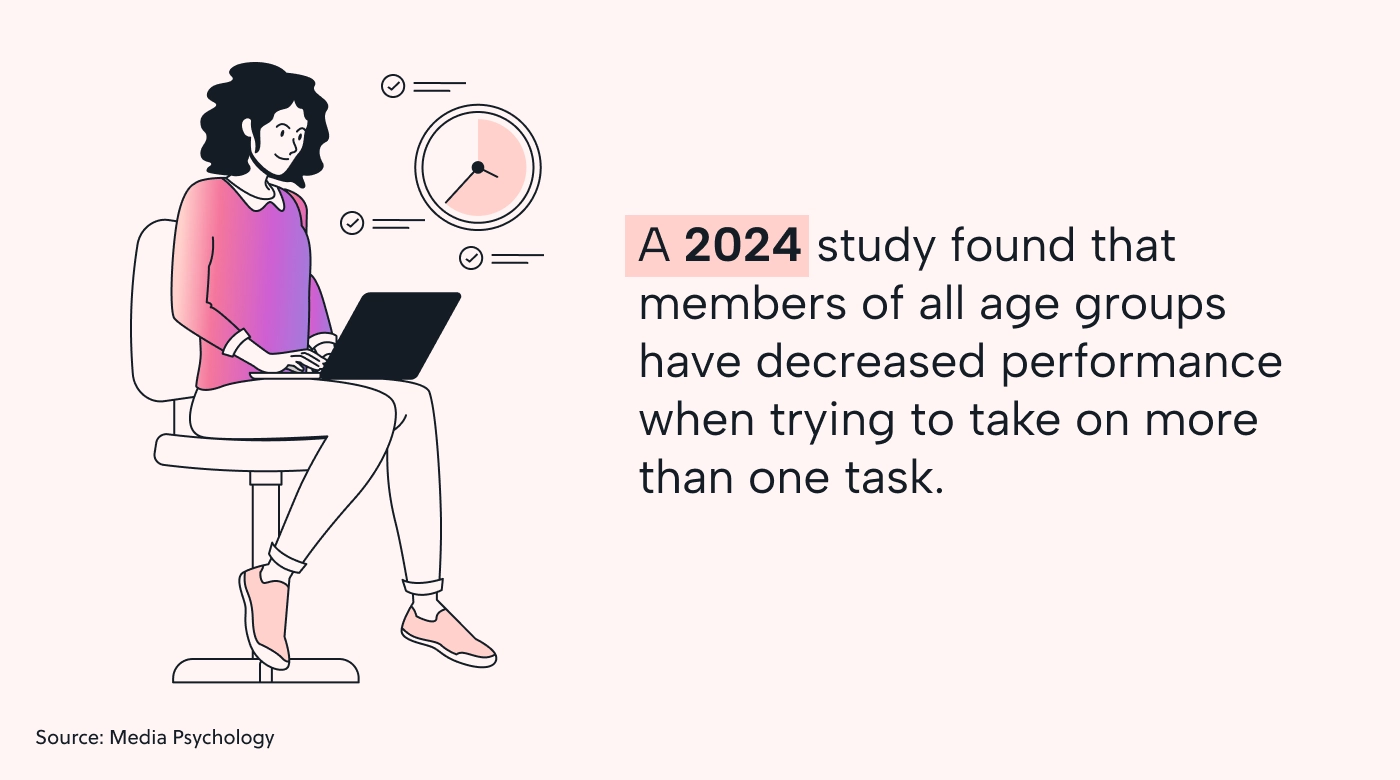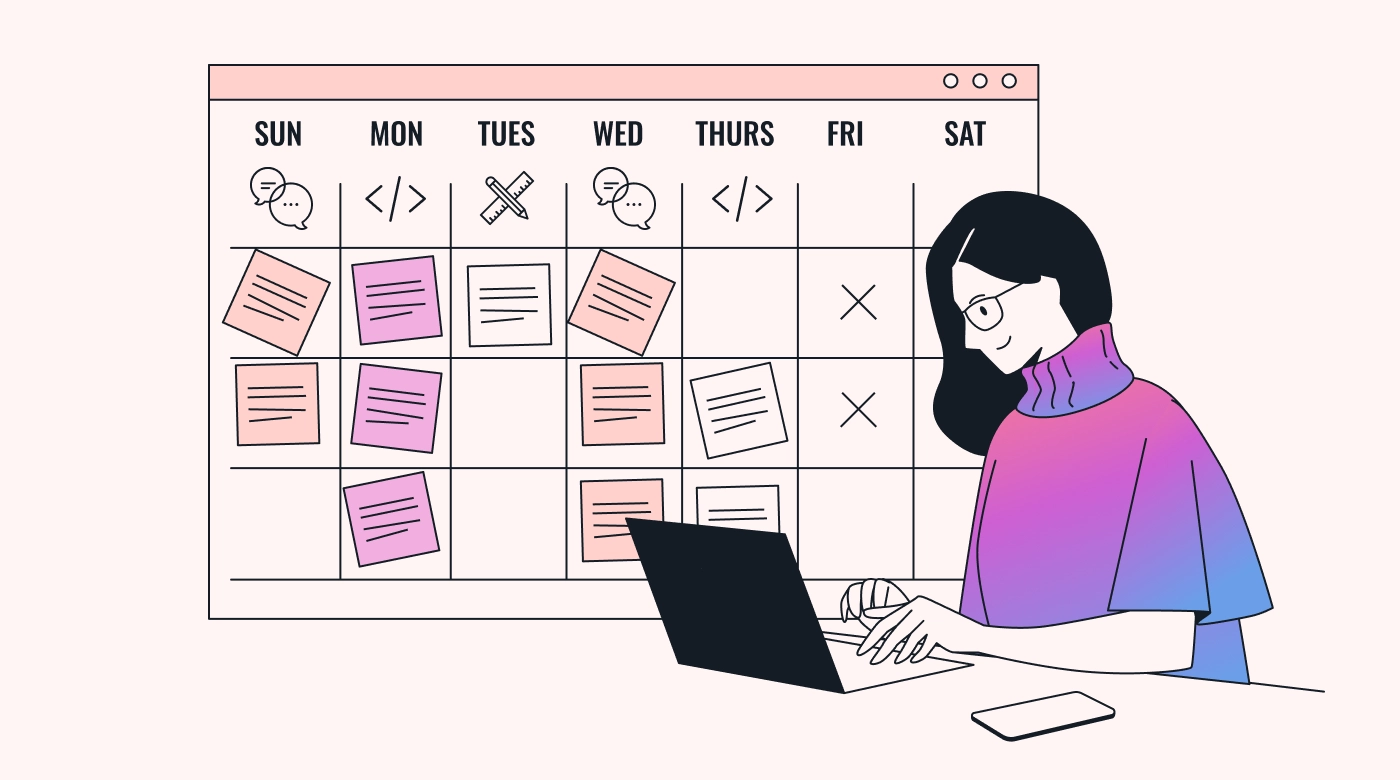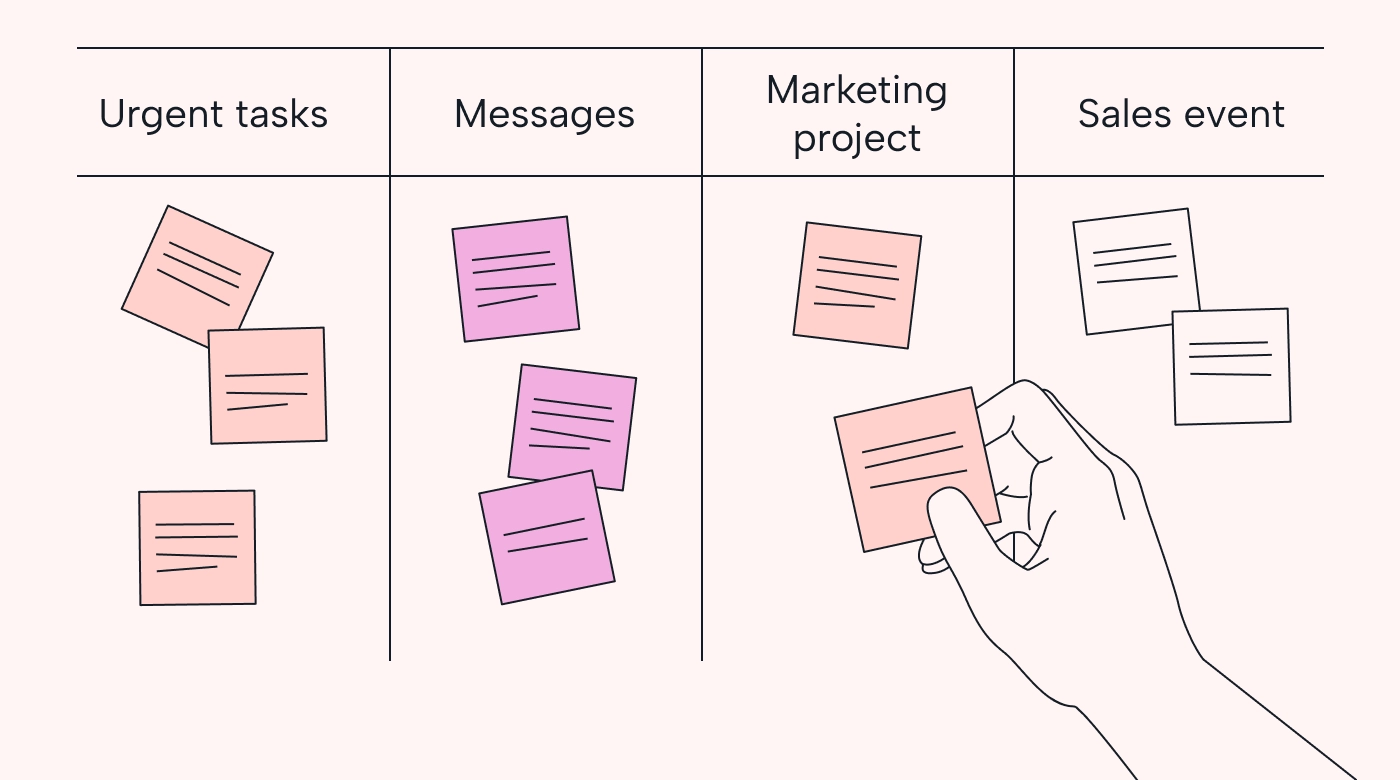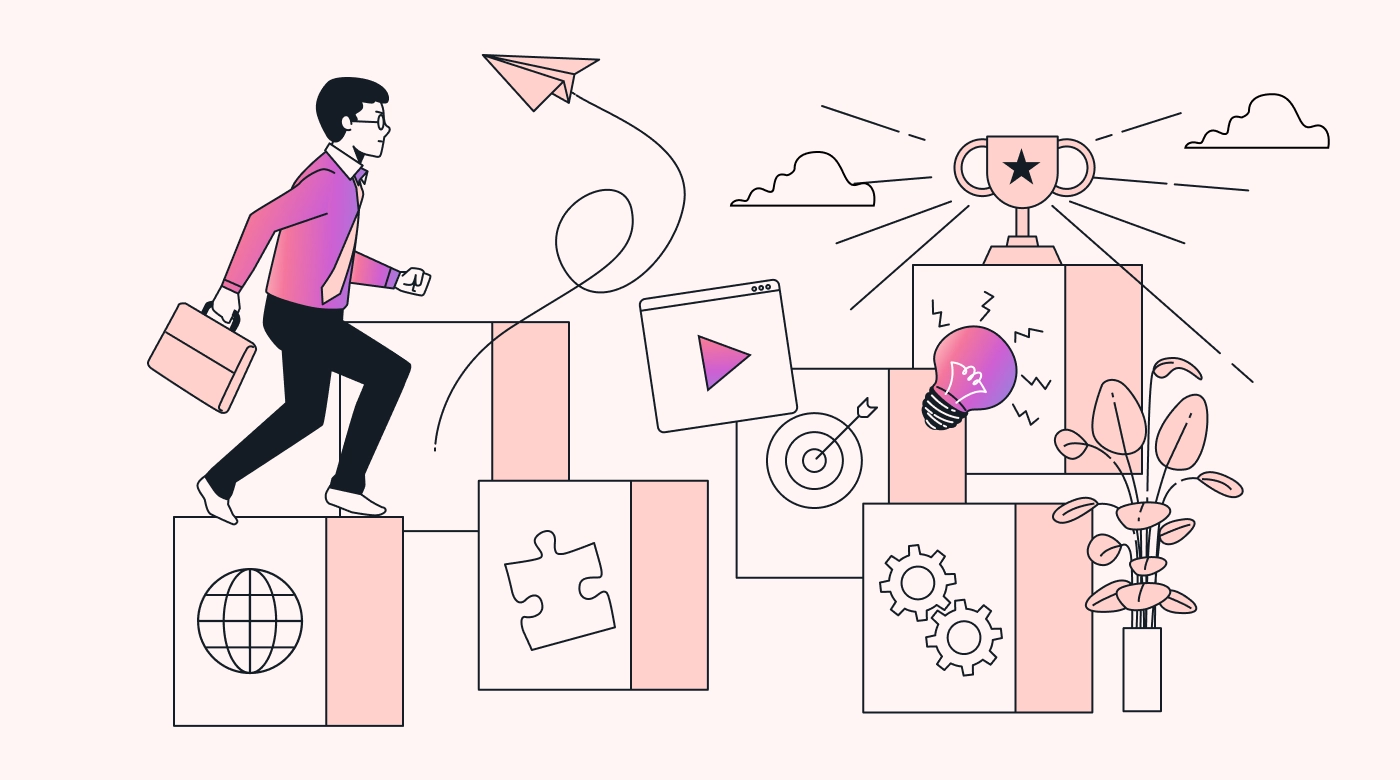You’ve probably heard the phrase “work smarter, not harder.” The idea is compelling. But it’s not always clear how to work smarter.
In this article, we take those words and turn them into actions. We show you how to boost your productivity without adding more to your plate.
Why it’s so hard to work smarter, not harder
The modern work environment is rife with distractions as well as opportunities. And it’s on us to navigate this complex and ever-changing landscape in an effective way.
Here are the two main issues we have to overcome:
Mental roadblocks
Sometimes, we create barriers ourselves. That’s the case with fear of failure, perfectionism, and lack of motivation. This is why mental health and the right mindset are so critical for productivity.
Still, the exact cause of these roadblocks isn’t always easy to pin down.
Take procrastination, for example. Research suggests that genetics and temperament can be partly to blame. And our work environment can be a culprit, too. The modern workplace is barraged with emails and notifications, robbing our ability to focus.
Many executives also report being overwhelmed by "pointless interactions that drain their energy and produce information overload."
All these variables add up to one clear conclusion: your mental skillset — the ability to concentrate, stay motivated, think creatively, and prioritize — is invaluable.
Poor work habits
There’s a widespread need for better work strategies and organizational skills. In fact, many individuals struggle with the following:
- Poor time management
- Unclear prioritization
- Inefficient work processes
These issues represent a lack of training. Employees need more knowledge and skills to better manage their workloads.
Furthermore, it’s easy to push aside physical and mental well-being for temporary gains. However, poor sleep and unhealthy habits eventually reduce productivity and pave the way for burnout.
What happens when you put the “work smarter, not harder” idea into action?
Let’s see the other side of the coin. When you’re able to implement the “work smarter, not harder” approach, you can reap the following benefits:
Improved well-being
Implementing smarter work practices can greatly reduce stress and help prevent burnout. This occurs because employees aren’t constantly overwhelmed by impossible workloads and expectations.
 |
With smart work practices, employees have more time to rest and rejuvenate, leading to better mental health. It then becomes easier for them to maintain a healthy work-life balance, contributing to their overall life satisfaction and well-being.
Team strengthening
When teams adopt smarter work practices, a culture of trust, autonomy, and collaboration develops. This makes it easier for employees to connect to your organization’s culture, and they’ll be almost four times as likely to be engaged with their work as a result.
These patterns continue to feed into each other, driving greater success individually and collectively.
Professional advantages
Working smarter gives teams a competitive edge by making them more efficient and effective. And if they’re achieving more results in less time, that opens the door for career advancement and long-term, strategic moves.
For example, say a marketing professional implements an automated reporting tool, and it cuts down on the time she needs to spend compiling reports. She is then able to focus more on data analysis and strategy. This leads to an especially successful project, earning her a promotion.
15 productivity-boosting tips to work smarter, not harder
We’ll start with 15 tips to help you work more effectively.
1. Use the 2-minute rule
If a task can be completed in less than two minutes, tackle it immediately.
This approach keeps small tasks from clogging up your to-do list. It helps maintain mental clarity and reduces overwhelming feelings.
You can use smart devices to quickly set reminders or complete simple tasks with voice-activated technology. Plus, email templates can automate responses to common inquiries, helping you knock out those tasks quickly.
2. Single-task for focus
Dedicate your full attention to one task at a time.
Single-tasking prevents the problems that come with multitasking, such as more frequent mistakes and longer completion times.
 |
By focusing on one task, you produce higher-quality work, making each work session more productive.
You can adopt short chunks of regular time for single-tasking using the Pomodoro technique. Or, for more creative or deep-diving tasks, take long stretches of time using the flowtime technique.
3. Maintain “Inbox Zero”
Make it a habit to regularly clean out your email inbox.
This practice helps you stay organized and keeps you from missing important communications. A clean inbox also reduces stress and decision fatigue.
You can also set advanced filters to automatically sort incoming emails by priority, project, or sender.
Even better, it’s good practice to unsubscribe aggressively. Regularly review and unsubscribe from newsletters or updates that no longer provide value to you.
4. Apply the 80/20 rule
Concentrate on the 20% of tasks that produce 80% of the results.
Focus your energy and resources on high-impact tasks, such as strategic planning or meeting with key clients. Delegate tasks that are the inverse of 80/20 (the less impactful 80%).
At the end of each week, you can review and evaluate which tasks in the coming week are most important.
5. Design a minimalist workspace
Create a work environment free from clutter.
A minimalist workspace has fewer distractions. It promotes a focused and calm working atmosphere.
End each day with a clean desk so that you start each morning fresh. A small plant or piece of art you love can help you feel more present and focused.
You can also designate part of your workspace as a “no electronic devices” area.
6. Set themes for weekdays
Designate specific days to focus on different types of work.
 |
For example, meetings could be on Mondays, and Tuesdays could be set aside for uninterrupted work.
It’s a good idea to set aside at least one day per week to be meeting-free so that you can focus.
These themed days reduce the cognitive load of switching contexts.
Consider using color-coded calendars or planners to better see the different themes you set.
7. Create an “if, then” plan for distractions
Develop proactive strategies to help you manage distractions that pop up.
For instance, if you find you get easily distracted by social media, your plan could be to close all social media tabs and set a 20-minute timer for focused work.
This is a great way to train your brain to recognize and counteract distractions automatically.
You can also keep a log of distractions and how to respond to them. Or set up a reward for each “if, then” plan you make.
8. Make technology your friend
Use tools to automate repetitive tasks.
Let technology help with tasks such as data entry, scheduling communications, and managing social media.
No-code platforms can help you develop custom solutions if you don’t have coding expertise. And voice recognition can make taking notes easier.
Motion brings many tasks under one roof and creates a central platform — making it far more powerful than just a to-do list app.
9. Set hard stops for work
Enforce strict time limits for meetings, work sessions, and your workday in general.
The goal here is to boost your productivity while also preventing you from overworking. It makes sure your work time doesn’t bleed into your personal time.
Have a ritual to mark the end of your workday. This could be a brief meditation session, a walk, or something else entirely — anything that signals to your brain that work is complete.
10. Work in short bursts
Work in focused bursts of time, followed by short breaks.
This method of managing your time helps maintain concentration and prevent fatigue.
Experiment with the Pomodoro technique, where you work anywhere from 20 to 30 minutes before taking a 5-minute break. Or, use time blocking if that amount of time feels too short for a session.
The purpose here is to find a natural rhythm where you can work productively and then rest to recharge (before repeating the cycle).
11. Batch similar tasks together
Group similar tasks together and tackle them in one go.
 |
By combining similar tasks, you streamline your workflow and minimize the time lost to task-switching. Task batching is particularly effective for repetitive tasks like email responses or bill payments.
Spend the last few minutes of your workday organizing tasks into batches for the next day so that you know you’ll have a focused start.
12. Incorporate AI into your workflows
Use the power of AI to unlock your potential at work.
Leverage AI assistants to learn your preferences over time. These tools are also great for analyzing data, helping with decision-making, generating first drafts, setting automatic reminders, and transcribing meetings.
13. Master the art of micro-scheduling
Divide your workday into small, manageable segments.
Micro-scheduling helps you maintain a workable task load since the chunks of work time are smaller. It can also extend to micro-breaks, where you incorporate short but helpful activities, like stretching or deep breathing, into your workday.
You can base different segments of the day on your energy level and how it pairs with various tasks. For example, you might feel more creative during the mornings and have admin-heavy afternoons.
14. Turn your commute into a learning session
Transform passive commute time into active learning opportunities.
Listen to podcasts or audiobooks related to your field to turn what would otherwise be downtime into productive knowledge and skill-building sessions.
You can also expand your horizons by listening to less directly related topics, such as inspiring biographies or self-help books. Or, if you want a more active experience, learn a new language or play problem-solving games.
15. Adopt silent hours
Set aside time when all notifications are turned off and your coworkers can’t distract you.
Establish designated periods during your workday with no notifications or interruptions. Notify your coworkers of these times or set visual cues near your workspace. This will let you focus on completing good, productive work.
The final 5 tips: How managers can help teams work smarter
These last five tips will help leaders incorporate strategies to work smarter at the team level.
16. Incorporate gamification
Make task completion a game with rewards and milestones.
 |
Managers can motivate their teams to improve with incentives. Set up systems where team members earn points, badges, or rewards when they complete tasks or achieve milestones. This approach makes work more engaging and competitive — and in a healthy way.
Performance leaderboards can be a fun, lighthearted way of tracking your team’s progress.
17. Work more mindfully
Encourage your team to engage in regular mindfulness.
Host mindfulness exercises and meditation sessions during work hours. These bring your team together outside of their normal work activities, helping to facilitate team bonding and collective thinking.
Meditation itself can help orient your team toward more productive work, and mindfulness can help improve concentration, reduce stress, and enhance creative thinking.
18. Hold “learning lunches”
Organize weekly learning lunches where team members can share knowledge, skills, and industry updates in a relaxed setting. This is also a great way to strengthen team bonds and drive development.
You can let different team members host each week. Or invite outside experts or mentors to bring in additional energy and insights.
19. Use creative sabbaticals for problem-solving
Give team members regular breaks to pursue creative projects or learn new skills.
While these pursuits aren’t directly related to their workload, these sabbaticals can reinvigorate your team and lead to innovative solutions. Supporting these breaks demonstrates a commitment to employee growth and well-being.
You can encourage staff to explore different fields unrelated to their work. This exploration often stimulates new ideas and ways of thinking that end up benefiting the organization.
20. Implement a four-day workweek
Embrace the emerging trend of a shorter workweek.
Research supports the idea that four-day workweeks improve productivity and employee satisfaction. Test out this model to see if it motivates your team to work more efficiently during their normal hours.
Let Motion help you do your best work
There you have it — a list of action-packed tips to work smarter, not harder. Consider starting with just one or two of them and return to them over time to give yourself a refresher.
Keep in mind, too, that one of the best ways to work at your best is through the right technology.
Motion takes care of everything — from project management to automated scheduling and so much more — in one app. Try it for free today!

Jared Posey is a business, SaaS, and productivity freelance writer with a passion for conencting readers with high-quality content. When he's not polishing up a sentence or conducting SERP research, you'll find him making his kids laugh and his wife shake her head.




